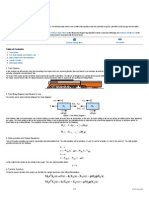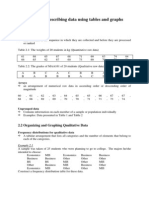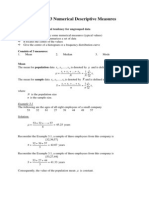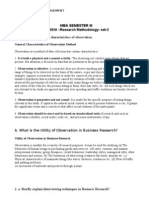Chapter 9
Chapter 9
Uploaded by
Khay OngCopyright:
Available Formats
Chapter 9
Chapter 9
Uploaded by
Khay OngOriginal Description:
Copyright
Available Formats
Share this document
Did you find this document useful?
Is this content inappropriate?
Copyright:
Available Formats
Chapter 9
Chapter 9
Uploaded by
Khay OngCopyright:
Available Formats
Chapter 9 Hypothesis Tests: Single Population
9.1 Hypothesis Tests
- In statistics, a hypothesis is a claim or statement about a property of a population.
- A hypothesis test (or test of significance) is a standard procedure for testing a
claim about a property of a population.
9.1.1 Components of a Formal Hypothesis Test
- The null hypothesis (denoted by H
0
) is a statement that the value of a population
parameter is assumed to be true until it is declared false.
- The alternative hypothesis (denoted by H
1
or H
a
) is the statement that the
parameter has a value that somehow differs from the null hypothesis.
- Consider as a nonstatistical example a person who has been indicated for
committing a crime and is being tried in a court. Based on the available evidence,
the judge or jury will make one of two possible decisions:
1. The person is not guilty
2. The person is guilty
Null hypothesis: :
0
H The person is not guilty
Alternative hypothesis :
1
H The person is guilty
9.1.2 Rejection and nonrejection regions
- The critical region (or rejection region) is the set of all values of the test statistic
that cause us to reject the null hypothesis.
- The nonrejection region (or acceptance region) is the set of all values of the test
statistic that cause us not to reject the null hypothesis.
- The critical point is a value that separates the critical region and the nonrejection
region.
- The significance level (denoted by o) is the probability that the test statistic will
fall in the critical region when the null hypothesis is actually true.
9.1.3 Type I and Type II errors
- A Type I error occurs when a true null hypothesis is rejected. The value of o
represents the probability of committing this type of error, that is
) (
0 0
true is H rejected is H P = o
The value of o represents the significance level of the test.
- A Type II error occurs when a false null hypothesis is not rejected. The value of
| represents the probability of committing a Type II error, that is
) (
0 0
false is H rejected not is H P = |
The value of | 1 is called the power of the test. It represents the probability of
not making a Type II error.
9.1.4 Tails of a test
The tails in a distribution are the extreme regions bounded by critical values. Some
hypothesis tests are two-tailed (the critical region is in the two extreme regions), some are
left-tailed (the critical region is in the extreme left region) and some are right-tailed tests
(the critical region is in the extreme right region).
Example 9.2: Give the relevant null hypothesis and alternative hypothesis.
a) Knowing that the proportion of drivers who admit to running red lights is at least
0.5, test if the proportion has changed.
b) The mean height of professional basketball players is at most 7ft., test if the
claim has changed.
c) The standard deviation of IQ scores of actors is equal to 15, test if the score
i) has changed,
ii) is getting smaller,
iii) is getting bigger.
9.2 Hypothesis tests about : o known
Perform a test of hypothesis about population mean when the population standard
deviation is known. Three possible cases are
Case 1: If the following two conditions are fulfilled:
1. The sample size is small ( i.e., ) 30 < n
2. The population from which the sample is selected is normally distributed.
Use normal distribution to perform a test of hypothesis about .
Case 2: If the following condition is fulfilled:
1. The sample size is large (i.e., ) 30 > n
Use normal distribution to perform a test of hypothesis about .
Case 3: If the following two conditions are fulfilled:
1. The sample size is small ( i.e., ) 30 < n
2. The population from which the sample is selected is not normally distributed.
Use a nonparametric method to perform a test of hypothesis about .
9.2.1 Test statistic
- The test statistic is a value computed from the sample data, and it is used in
making the decision about the rejection of the null hypothesis
- Test statistic for mean,
n
x
z
o
=
- z is also called the calculated value/ observed value
9.2.2 The p-value approach
- Assuming that the null hypothesis is true, the p -value can be defined as the
probability that a sample statistic ( such as the sample mean) is at least as far
away from the hypothesized value in the direction of the alternative hypothesis as
the one obtained from the sample data under consideration.
- The p-value method in hypothesis testing
Right-tailed test: p-value = area to right of the test statistic z
Left-tailed test: p-value = area to left of the test statistic z
Two-tailed test: p-value = twice the area of the extreme region
bounded by the test statistic z
- Criteria of the decision making
Reject H
0
if p-value s o (the significance level)
Do not reject H
0
if p-value > o (the significance level)
Note that: p-value is the smallest significance level at which the null hypothesis is
rejected.
9.2.3 Steps to perform a test of hypothesis using the p-value approach
1. State the null and alternative hypothesis.
2. Select the distribution to use (test statistic).
3. Calculate the p-value.
4. Make a decision.
Example 9.1: A canon Food corporation, it took an average of 90 minutes for new
workers to learn a food processing job. Recently the company installed a new food
processing machine. The supervisor at the company wants to find if the mean time taken
by new workers to learn the food processing procedure on this new machine is different
from 90 minutes. A sample of 20 workers showed that it took, on average, 85 minutes for
them to learn the food processing procedure on the new machine. It is shown that the
learning times for all new workers are normally distributed with a population standard
deviation of 7 minutes. Find the p-value for the test that the mean learning time for the
food processing procedure on the new machine is different from 90 minutes. What will
your conclusion be if 01 . 0 = o ?
Solution:
Example 9.2: The management of Priority Health Club claims that its members lose an
average of 10 pounds or more within the first month after joining the club. A consumer
agency that wanted to check this claim took a random sample of 36 members of this
health club and found that they lost an average of 9.2 pounds within the first month of
membership. The population standard deviation is known to be 2.4 pounds. Find the p-
value for this test. What will your decision be if 01 . 0 = o ? What if 05 . 0 = o ?
Solution:
9.2.4 Critical-value approach
- We find the critical values(s) of z from the normal distribution table for the given
significance level.
- Compare the value of the test statistic with critical value and make a decision.
9.2.5 Steps to perform a test of hypothesis using the p-value approach
1. State the null and alternative hypothesis.
2. Select the distribution to use (test statistic).
3. Determine the rejection and nonrejection regions.
4. Calculate the value of the test statistic.
5. Make a decision.
Example 9.3: The TIV Telephone Company provides long-distance telephone service in
an area. According to the companys records, the average length of all long distances
calls placed through this company in 2004 was 12.44 minutes. The companys
management wanted to check if the mean length of the current long-distance calls is
different from 12.44 minutes. A sample of 150 such class placed through this company
produced a mean length of 13.71 minutes. The standard deviation of all such class is 2.65
minutes. Using the 2% significance level, can you conclude that the mean length of all
current long-distance calls is different from 12.44 minutes?
Solution:
Example 9.4: The mayor of a large city claims that the average net worth of families
living in this city is at least $300000. A random sample of 25 families selected from this
city produced a mean net worth of $288000. Assume that the net worths of all families in
this city have a normal distribution with the population standard deviation of $80000.
Using the 2.5% significance level, can you conclude that the mayors claim is false?
Solution:
9.3 Hypothesis Tests about : o not known
Perform a test of hypothesis about population mean when the population standard
deviation o is not known. Three possible cases are
Case 1: If the following two conditions are fulfilled:
1. The sample size is small ( i.e., ) 30 < n
2. The population from which the sample is selected is normally distributed.
Use t distribution to perform a test of hypothesis about .
Case 2: If the following condition is fulfilled
1. The sample size is large (i.e., ) 30 > n
Use normal distribution to perform a test of hypothesis about .
Case 3: If the following two conditions are fulfilled:
1. The sample size is small ( i.e., ) 30 < n
2. The population from which the sample is selected is not normally distributed (or
its distribution is unknown).
Use a nonparametric method to perform a test of hypothesis about .
9.3.1 Test statistic
- The value of the test statistic t for the sample mean x is computed as
x
s
x
t
= where
n
s
s
x
=
- The value of t calculated for x by using the above formula is also called the
observed value of t.
1. The p-value approach
Example 9.5: A psychologist claims that the mean age at which children start walking is
12.5 months. Carol wanted to check if this claim is true. She took a random sample of 18
children and found that the mean age at which these children started walking was 12.9
months with a standard deviation of 0.80 months. It is known that the ages at which all
children start walking are approximately normally distributed. Find the p-value for the
test that the mean age at which all children start walking is different from 12.5 months.
What will your conclusion be if the significance level is 1%?
Solution:
Example 9.6: Grand Auto Corporation produces auto batteries. The company claims that
its top-of-the-line Never Die batteries are good, on average, for at least 65 months. A
consumer protection agency tested 45 such batteries to check this claim. It found that the
mean life of these 45 batteries is 63.4 months and the standard deviation is 3 months.
Find the p-value for the test that the mean life of all such batteries is less than 65 months.
What will your conclusion be if the significance level is 2.5%?
Solution:
2. Critical-value approach
Example 9.7: A psychologist claims that the mean age at which children start walking is
12.5 months. Carol wanted to check if this claim is true. She took a random sample of 18
children and found that the mean age at which these children started walking was 12.9
months with a standard deviation of 0.80 months. Using the 1% significance level, can
you conclude that the mean age at which all children start walking is different from 12.5
months? It is known that the ages at which all children start walking are approximately
normally distributed.
Solution:
Example 9.8: The management at Massachusetts Savings Bank is always concerned
about the quality of service provided to its customers. With the old computer system, a
teller at this bank could serve, on average, 22 customers per hour. The management
noticed that with this service rate, the waiting time for customers was too long. Recently
the management of the bank installed a new computer system, expecting that it would
increase the service rate and consequently make the customers happier by reducing the
waiting time. To check if the new computer system is more efficient than the old system,
the management of the bank took a random sample of 70 hours and found that during
these hours the mean number of customers served by tellers was 27 per hour with a
standard deviation of 2.5. Testing at the 1% significance level, would you conclude that
the new computer system is more efficient than the old computer system?
Solution:
9.4 Hypothesis tests about a population proportion : Large samples
- In tests of hypothesis about p for large samples ( np>5, n(1-p) > 5 ), the test
statistic is
n pq
p p
z
=
- The value of p is the one used in the null hypothesis, p q =1 .
Example 9.9: When working properly, a machine that is used to make chips for
calculators does not produce more than 4% defective chips. Whenever the machine
produces more than 4$ defective chips, it needs an adjustment. To check if the machine is
working properly, the quality control department at the company often takes samples of
chips and inspects them to determine if they are good or defective. One such random
sample of 200 chips taken recently from the production line contained 12 defective chips.
a) Find the p-value to test the hypothesis whether or not the machine needs an
adjustment.
b) What would your conclusion be if the significance level is 2.5%?
Solution:
You might also like
- VB Map PECSDocument32 pagesVB Map PECSsuisen100% (4)
- Icofom 1985Document97 pagesIcofom 1985Italo AraujoNo ratings yet
- ARF - 01 - Pendahuluan - Bahan Konstruksi Teknik Kimia (BKTK)Document13 pagesARF - 01 - Pendahuluan - Bahan Konstruksi Teknik Kimia (BKTK)nurmaNo ratings yet
- Gravimetric Determination of Calcium As Calcium Oxalate: University of St. La Salle Experiment No. 3Document10 pagesGravimetric Determination of Calcium As Calcium Oxalate: University of St. La Salle Experiment No. 3Ray AribatoNo ratings yet
- How To Prove That (A X (B X C) ) B (A.C) - C (A.B) - QuoraDocument13 pagesHow To Prove That (A X (B X C) ) B (A.C) - C (A.B) - QuoraEugenio Capiello100% (1)
- Chapter 3Document81 pagesChapter 3Ricky Putra SiregarNo ratings yet
- Mirror, Mirror First 13 PagesDocument17 pagesMirror, Mirror First 13 Pagestore larsenNo ratings yet
- PPKU06 07 Modelling Asosiasi Korelasi RegresiDocument58 pagesPPKU06 07 Modelling Asosiasi Korelasi RegresiImam BaihaqiNo ratings yet
- 23 Application of Geometrical Tolerances 2020 Manual of Engineering DrawinDocument36 pages23 Application of Geometrical Tolerances 2020 Manual of Engineering Drawin96xbntwjymNo ratings yet
- 01 Muatan Listrik & Hukum CoulombDocument26 pages01 Muatan Listrik & Hukum CoulombIndra AtmajaNo ratings yet
- Coupled PendulamsDocument5 pagesCoupled PendulamsHarsh VermaNo ratings yet
- Problem 5.1ADocument53 pagesProblem 5.1ALuis PiscalNo ratings yet
- Chapter6-Electrochemistry (Part 2)Document27 pagesChapter6-Electrochemistry (Part 2)Uswatun KhasanahNo ratings yet
- Tugas Segitiga PascalDocument2 pagesTugas Segitiga PascalHardiyansahNo ratings yet
- Tugas Debi Putri Suprapto Matakuliah Perpindahan Panas 2 PDFDocument48 pagesTugas Debi Putri Suprapto Matakuliah Perpindahan Panas 2 PDFDebi Putri SupraptoNo ratings yet
- Materi TOEFL 02 FebruariDocument66 pagesMateri TOEFL 02 FebruariJoni MillerNo ratings yet
- Appendix e ThermoDocument17 pagesAppendix e ThermoNadia khalizaNo ratings yet
- Reading-SkimmingscanningDocument4 pagesReading-SkimmingscanningCarlos Mario Ramirez CaperaNo ratings yet
- Cacat KristalDocument12 pagesCacat KristalBudi IstanaNo ratings yet
- Diagramas de Gurney-LurieDocument13 pagesDiagramas de Gurney-LurieMarcelaEduardaNo ratings yet
- Soal Soal Ekonomi Teknik KimiaDocument2 pagesSoal Soal Ekonomi Teknik KimiapratitatriasalinNo ratings yet
- HW 2 PRDDocument3 pagesHW 2 PRDUlya HalimahNo ratings yet
- Gabungan - Hasil Try Out - Ipa-3Document46 pagesGabungan - Hasil Try Out - Ipa-3Jhon Bryan Zico TarihoranNo ratings yet
- Abe 106 - 04Document42 pagesAbe 106 - 04emmanuelNo ratings yet
- Bab 2Document13 pagesBab 2Teguh Novri YansyahNo ratings yet
- DISTRIBUSI BETA (Menentukan Varian)Document2 pagesDISTRIBUSI BETA (Menentukan Varian)yantiayaNo ratings yet
- CHE 312 - Assignment 1 - Due On July 16Document2 pagesCHE 312 - Assignment 1 - Due On July 16Abdi Ahmed0% (1)
- SCR, Ujt, Triac, DiacDocument30 pagesSCR, Ujt, Triac, DiacGhinsGONo ratings yet
- Pengembangan Alat Musschenbroek Dan Panduan Praktikumnya Untuk Membangun Inkuiri Siswa Fathin Irina Diatri Agus Suyatna AbdurrahmanDocument9 pagesPengembangan Alat Musschenbroek Dan Panduan Praktikumnya Untuk Membangun Inkuiri Siswa Fathin Irina Diatri Agus Suyatna AbdurrahmanMeilia HermawanNo ratings yet
- NI Tutorial 6435 enDocument4 pagesNI Tutorial 6435 enNirmal Kumar PandeyNo ratings yet
- Praktikum Metal 1Document27 pagesPraktikum Metal 1Muhammad Aldi Luthfi FauzanNo ratings yet
- Measurement Systems: Application and Design by Ernest O. DoebelinDocument19 pagesMeasurement Systems: Application and Design by Ernest O. DoebelinAlhji AhmedNo ratings yet
- Stoikiometri TaskDocument5 pagesStoikiometri TaskAnanNo ratings yet
- Soal KRKK NewDocument6 pagesSoal KRKK NewGita WulandariNo ratings yet
- Tugas Dasar DigitalDocument22 pagesTugas Dasar DigitalMaya Syarah RitongaNo ratings yet
- Fortran Programming Language For Antoine Equation (Finding Bubble and Dew Point)Document2 pagesFortran Programming Language For Antoine Equation (Finding Bubble and Dew Point)DyahKuntiSuryaNo ratings yet
- The Sorcery of ApprenticeshipDocument2 pagesThe Sorcery of Apprenticeship16520456 Muhammad Risqi FirdausNo ratings yet
- Homework of Bernoulli EqDocument8 pagesHomework of Bernoulli EqSinggih OktavianNo ratings yet
- Contoh Soal Keseimbangan 2DDocument3 pagesContoh Soal Keseimbangan 2DS SalmanNo ratings yet
- Contoh Soal ViskositasDocument2 pagesContoh Soal ViskositaswsdodoNo ratings yet
- Nilai PM Mat Du 112 17042022Document9 pagesNilai PM Mat Du 112 17042022Afrizal Surya PutraNo ratings yet
- Problem: CommentDocument3 pagesProblem: CommentBhavneet Kaur Hardeep Singh Khalsa (B20CH012)No ratings yet
- Contoh Soal Radiasi Dan KonveksiDocument5 pagesContoh Soal Radiasi Dan Konveksi038 - ahmad sidikNo ratings yet
- 05 Present Worth AnalysisDocument24 pages05 Present Worth AnalysisRio ZulmansyahNo ratings yet
- ElectrochemistryDocument65 pagesElectrochemistryAhom CK100% (2)
- Che3202 5 2010 2Document7 pagesChe3202 5 2010 2Priyam RamsokulNo ratings yet
- Annual Worth CalculationDocument15 pagesAnnual Worth CalculationShabrina AdaniNo ratings yet
- Rose EquationDocument3 pagesRose Equationأبو أسامة حمدي100% (1)
- Activated SludgeDocument9 pagesActivated SludgeDwi Rezky WidiantoNo ratings yet
- Dimensional Analysis (Rayleigh Dan Buckingham PI)Document8 pagesDimensional Analysis (Rayleigh Dan Buckingham PI)amiennuddin sanifNo ratings yet
- Latihan Systematic Random Sampling2Document3 pagesLatihan Systematic Random Sampling2Dwi Satria FirmansyahNo ratings yet
- Table A.1 Binomial Probability Sums B (X N, P)Document11 pagesTable A.1 Binomial Probability Sums B (X N, P)coolth2No ratings yet
- Assignment#2 Mekanika Fluida Teknik Kimia CE3105Document6 pagesAssignment#2 Mekanika Fluida Teknik Kimia CE3105Ananda Cahya100% (1)
- Day 3 Derivation QuizDocument1 pageDay 3 Derivation Quiznadiafatiana17No ratings yet
- Laplace Table PDFDocument2 pagesLaplace Table PDFIlham Perdana ATNo ratings yet
- The Isothermal Van't Hoff Equation For Phase Equilibria-A Forgotten Relation?Document6 pagesThe Isothermal Van't Hoff Equation For Phase Equilibria-A Forgotten Relation?JESUS DAVID BOLA‹O JIMENEZNo ratings yet
- Bab 10Document79 pagesBab 10Vincentius EkyNo ratings yet
- Hypothesis Testing RevisedDocument22 pagesHypothesis Testing RevisedBrafiel Claire Curambao LibayNo ratings yet
- Eda ResearchDocument11 pagesEda ResearchAmor GacayanNo ratings yet
- StatDocument70 pagesStatcj_anero67% (3)
- Hypothesis Testing GDocument28 pagesHypothesis Testing GRenee Jezz LopezNo ratings yet
- T - TestDocument32 pagesT - TestDrRuchi Garg100% (2)
- Chapter V Tests of Hypothesis 6Document67 pagesChapter V Tests of Hypothesis 6ewitgtavNo ratings yet
- Tutorial 4Document2 pagesTutorial 4Khay OngNo ratings yet
- Tutorial 9Document1 pageTutorial 9Khay OngNo ratings yet
- Tutorial 6Document1 pageTutorial 6Khay OngNo ratings yet
- Tutorial 8Document1 pageTutorial 8Khay OngNo ratings yet
- Maa 161 Statistics For Sciences Students Tutorial 11: No. of Heads FrequencyDocument1 pageMaa 161 Statistics For Sciences Students Tutorial 11: No. of Heads FrequencyKhay OngNo ratings yet
- Tutorial 7Document1 pageTutorial 7Khay OngNo ratings yet
- Gunaan CONTENT 2011-2012Document42 pagesGunaan CONTENT 2011-2012Khay OngNo ratings yet
- Tutorial 5Document2 pagesTutorial 5Khay OngNo ratings yet
- Tutorial 1Document2 pagesTutorial 1Khay OngNo ratings yet
- Chapter 10Document13 pagesChapter 10Khay OngNo ratings yet
- Solutions of Tutorial 5Document2 pagesSolutions of Tutorial 5Khay OngNo ratings yet
- Chapter 11Document6 pagesChapter 11Khay OngNo ratings yet
- Tutorial 3Document2 pagesTutorial 3Khay OngNo ratings yet
- Chapter 2 Describing Data Using Tables and GraphsDocument16 pagesChapter 2 Describing Data Using Tables and GraphsKhay OngNo ratings yet
- Chapter 7Document15 pagesChapter 7Khay OngNo ratings yet
- Chapter 6Document16 pagesChapter 6Khay OngNo ratings yet
- Chapter 4Document14 pagesChapter 4Khay OngNo ratings yet
- Chapter 3 Numerical Descriptive Measures: 3.1 Measures of Central Tendency For Ungrouped DataDocument14 pagesChapter 3 Numerical Descriptive Measures: 3.1 Measures of Central Tendency For Ungrouped DataKhay OngNo ratings yet
- Applications of The Laplace TransformDocument81 pagesApplications of The Laplace TransformMochamad Nandradi ToyibNo ratings yet
- New Technique For Hiding Data in Audio and Image With Multilevel ProtectionDocument4 pagesNew Technique For Hiding Data in Audio and Image With Multilevel ProtectionijsretNo ratings yet
- E-Travel Management System 1pptDocument11 pagesE-Travel Management System 1pptSandesh AhirNo ratings yet
- Oil For Marine Navigation PDFDocument6 pagesOil For Marine Navigation PDFCorina StanculescuNo ratings yet
- ASIET B.Tech NRI FormsDocument2 pagesASIET B.Tech NRI FormsAnweshaBoseNo ratings yet
- Leading and Managing The Lean Management ProcessDocument14 pagesLeading and Managing The Lean Management ProcessBusiness Expert PressNo ratings yet
- Infix Prefix PostfixDocument4 pagesInfix Prefix PostfixShobhit MehrotraNo ratings yet
- Sentence and PropositionDocument15 pagesSentence and PropositionManika KhetarpalNo ratings yet
- Words From Official SAT Study GuideDocument22 pagesWords From Official SAT Study GuideAsadIjazNo ratings yet
- As 1580.108.1 DFT NDTDocument5 pagesAs 1580.108.1 DFT NDTMahendra DhamalNo ratings yet
- Kolb's Learning Styles and Experiential Learning ModelDocument9 pagesKolb's Learning Styles and Experiential Learning ModellabiangelNo ratings yet
- c5 Eval InstructionsDocument5 pagesc5 Eval InstructionsTravis BennettNo ratings yet
- Explain The General Characteristics of Observation.: Mba Semester Iii MB0050 - Research Methodology-Set-2Document22 pagesExplain The General Characteristics of Observation.: Mba Semester Iii MB0050 - Research Methodology-Set-2Arup Kumar NandiNo ratings yet
- Type-A ESM DatasheetDocument4 pagesType-A ESM DatasheetKesNo ratings yet
- ACTION Plan ResearchDocument6 pagesACTION Plan ResearchVon Lloyd Ledesma LorenNo ratings yet
- Godfrey Book ObjectivesDocument5 pagesGodfrey Book ObjectiveshaldoisNo ratings yet
- Transcript Aptis ListeningDocument2 pagesTranscript Aptis Listeningluonganhminh559No ratings yet
- Homework 03Document2 pagesHomework 03marimarxanNo ratings yet
- Smith, Shannon ResumeDocument2 pagesSmith, Shannon Resumeapi-280937982No ratings yet
- IEEE Neutral+Conductor+CurrentDocument7 pagesIEEE Neutral+Conductor+CurrenttshiotshieNo ratings yet
- Sam Ho - Partnership With The Stakeholders in Assuring Quality in Skills Development - Stories of The HKCAAVQDocument5 pagesSam Ho - Partnership With The Stakeholders in Assuring Quality in Skills Development - Stories of The HKCAAVQP'tit GerNo ratings yet
- Conceptual Framework For Financial ReportingDocument1 pageConceptual Framework For Financial Reportingsadegh.ab1380No ratings yet
- ReferencesDocument73 pagesReferencesstwilfredsNo ratings yet
- Kamil Patel (Resume)Document3 pagesKamil Patel (Resume)kamil patelNo ratings yet
- MATH 21EE Advanced Engineering Mathematics For EEDocument6 pagesMATH 21EE Advanced Engineering Mathematics For EEYber LexNo ratings yet
- Maths WorksheetsDocument22 pagesMaths WorksheetsUmer QadirNo ratings yet
- Grade 5 Cycle Test March 2023Document6 pagesGrade 5 Cycle Test March 2023wamulumeleahNo ratings yet











































































































